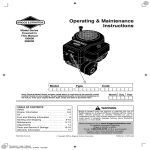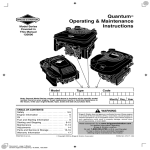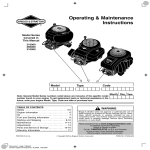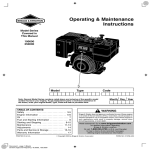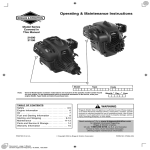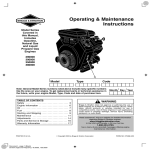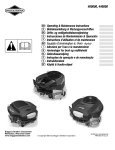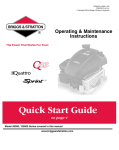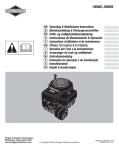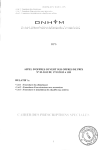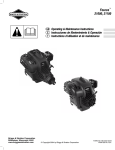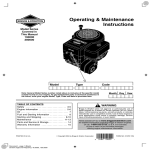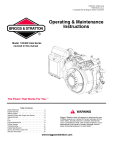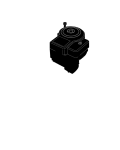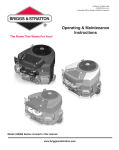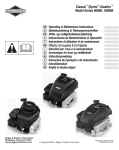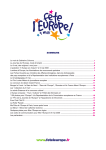Download Briggs & Stratton VANGUARD 540000 User's Manual
Transcript
Operating & Maintenance Instructions Model Series Covered in This Manual 470000 540000 Model Type Code Note: General Model Series numbers noted above are inclusive of the specific model number found on your engine. To get replacement parts or technical assistance in the future, write your engine Model, Type, Code and date of purchase here. TABLE OF CONTENTS Emission Information . . . . . . . . . . . . . . . . . . . . . . 2 Safety . . . . . . . . . . . . . . . . . . . . . . . . . . . . . . . . . 3-5 Engine Information . . . . . . . . . . . . . . . . . . . . . . 5-7 Oil . . . . . . . . . . . . . . . . . . . . . . . . . . . . . . . . . . . . . . . 8 Fuel and Coolant . . . . . . . . . . . . . . . . . . . . . . . . . . 9 Starting and Stopping . . . . . . . . . . . . . . . . . . . . . 10 Maintenance . . . . . . . . . . . . . . . . . . . . . . . . . 11-14 Adjustments . . . . . . . . . . . . . . . . . . . . . . . . . . 14-15 Parts and Service & Storage . . . . . . . . . . . . . . . 16 Warranty Information . . . . . . . . . . . . . . . . . . . . . 17 PRINTED IN U.S.A. Month Day Year WARNING Briggs & Stratton does not approve or authorize the use of these engines on 3-wheel All Terrain Vehicles (ATVs), motor bikes, aircraft products or vehicles intended for use in competitive events. Use of these engines in such applications could result in property damage, serious injury (including paralysis), or even death. Need assistance? Go to www.briggsandstratton.com for detailed information regarding Briggs & Stratton engines. Or call, 1-800-233-3723, (U.S.A. and Canada) to hear a menu of pre-recorded messages offering engine maintenance information. Copyright 2003 by Briggs & Stratton Corporation FORM NO. 275723-5/03 The Power That Works For You. Look For Relevant Emissions Durability Period and Air Index Information On Your Engine Emissions Label Engines that are certified to meet the California Air Resources Board (CARB) Tier 2 Emission Standards must display information regarding the Emissions Durability Period and the Air Index. Briggs & Stratton makes this information available to the consumer on our emission labels. The Emissions Durability Period describes the number of hours of actual running time for which the engine is certified to be emissions compliant, assuming proper maintenance in accordance with the Operating & Maintenance Instructions. The following categories are used: Moderate: Engine is certified to be emission compliant for 125 hours of actual engine running time. Intermediate: Engine is certified to be emission compliant for 250 hours of actual engine running time. Extended: Engine is certified to be emission compliant for 500 hours of actual engine running time. For example, a typical walk-behind lawn mower is used 20 to 25 hours per year. Therefore, the Emissions Durability Period of an engine with an intermediate rating would equate to 10 to 12 years. The Air Index is a calculated number describing the relative level of emissions for a specific engine family. The lower the Air Index, the cleaner the engine. This information is displayed in graphical form on the emissions label. After July 1, 2000, Look For Emissions Compliance Period On Engine Emissions Compliance Label After July 1, 2000 certain Briggs & Stratton engines will be certified to meet the United States Environmental Protection Agency (USEPA) Phase 2 emission standards. For Phase 2 certified engines, the Emissions Compliance Period referred to on the Emissions Compliance label indicates the number of operating hours for which the engine has been shown to meet Federal emission requirements. For engines less than 225 cc displacement, Category C = 125 hours, B = 250 hours and A = 500 hours. For engines of 225 cc or more, Category C = 250 hours, B = 500 hours and A = 1000 hours. The displacement of Model Series 470000 engines is 752 cc. The displacement of Model Series 540000 engines is 895 cc. This is a generic representation of the emission label typically found on a certified engine. 2 BEFORE OPERATING ENGINE • Read entire Operating & Maintenance Instructions AND the instructions for the equipment this engine powers.* • Failure to follow instructions could result in serious injury or death. THE OPERATING & MAINTENANCE INSTRUCTIONS CONTAIN SAFETY INFORMATION TO • Make you aware of hazards associated with engines • Inform you of the risk of injury associated with those hazards, and • Tell you how to avoid or reduce the risk of injury. ( ) HAZARD SYMBOLS AND MEANINGS is used to identify safety The safety alert symbol information about hazards that can result in personal injury. A signal word (DANGER, WARNING, or CAUTION) is used with the alert symbol to indicate the likelihood and the potential severity of injury. In addition, a hazard symbol may be used to represent the type of hazard. Fire Explosion Moving Parts DANGER indicates a hazard which, if not avoided, will result in death or serious injury. Toxic Fumes Hot Surface Shock WARNING indicates a hazard which, if not avoided, could result in death or serious injury. Hot Liquid or Steam CAUTION indicates a hazard which, if not avoided, might result in minor or moderate injury. THE INTERNATIONAL SYMBOLS USED ON THE ENGINE OR IN THIS MANUAL INCLUDE: CAUTION, when used without the alert symbol, indicates a situation that could result in damage to the engine. WARNING Safety Alert The engine exhaust from this product contains chemicals known to the State of California to cause cancer, birth defects, or other reproductive harm. * Kickback Oil Stop Read Owner’s Manual Fuel Shutoff Choke On Off Fuel Briggs & Stratton does not necessarily know what equipment this engine will power. For that reason, you should carefully read and understand the operating instructions for the equipment on which your engine is placed. 3 SAFETY WARNING WARNING Gasoline and its vapors are extremely flammable and explosive. Starting engine creates sparking. Sparking can ignite nearby flammable gases. Fire or explosion can cause severe burns or death. Explosion and fire could result. WHEN ADDING FUEL • If there is natural or LP gas leakage in area, do not start engine. • Do not use pressurized starting fluids because vapors are flammable. • Turn engine OFF and let engine cool at least 2 minutes before removing gas cap. • Fill fuel tank outdoors or in well-ventilated area. • Do not overfill fuel tank. Fill tank to approximately 1-1/2 inches below top of neck to allow for fuel expansion. • Keep gasoline away from sparks, open flames, pilot lights, heat, and other ignition sources. • Check fuel lines, tank, cap, and fittings frequently for cracks or leaks. Replace if necessary. WARNING WHEN STARTING ENGINE Rapid retraction of starter cord (kickback) will pull hand and arm toward engine faster than you can let go. • Make sure spark plug, muffler, fuel cap and air cleaner are in place. • Do not crank engine with spark plug removed. • If fuel spills, wait until it evaporates before starting engine. • If engine floods, set choke to OPEN/RUN position, place throttle in FAST and crank until engine starts. Broken bones, fractures, bruises or sprains could result. • When starting engine, pull cord slowly until resistance is felt, then pull rapidly. • Remove all external equipment/engine loads before starting engine. • Direct coupled equipment components such as, but not limited to, blades, impellors, pulleys, sprockets, etc., must be securely attached. WHEN OPERATING EQUIPMENT • Do not tip engine or equipment at angle which causes gasoline to spill. • Do not choke carburetor to stop engine. WHEN TRANSPORTING EQUIPMENT • Transport with fuel tank EMPTY or with fuel shut-off valve OFF. WHEN STORING GASOLINE OR EQUIPMENT WITH FUEL IN TANK WARNING • Store away from furnaces, stoves, water heaters or other appliances that have pilot light or other ignition source because they can ignite gasoline vapors. Rotating parts can contact or entangle hands, feet, hair, clothing, or accessories. Traumatic amputation or severe laceration can result. • • • • 4 Operate equipment with guards in place. Keep hands and feet away from rotating parts. Tie up long hair and remove jewelry. Do not wear loose-fitting clothing, dangling drawstrings or items that could become caught. SAFETY WARNING WARNING Running engines produce heat. Engine parts, especially muffler, become extremely hot. Engines give off carbon monoxide, an odorless, colorless, poison gas. Severe thermal burns can occur on contact. Breathing carbon monoxide can cause nausea, fainting or death. Combustible debris, such as leaves, grass, brush, etc. can catch fire. • Start and run engine outdoors. • Do not start or run engine in enclosed area, even if doors or windows are open. • Allow muffler, engine cylinder and fins to cool before touching. • Remove accumulated combustibles from muffler area and cylinder area. • Install and maintain in working order a spark arrester before using equipment on forest-covered, grass-covered, brush-covered unimproved land. The state of California requires this (Section 4442 of the California Public Resources Code). Other states may have similar laws. Federal laws apply on federal land. WARNING WARNING Unintentional sparking can result in fire or electric shock. Never remove radiator cap or radiator reservoir cap while the engine is hot or running. Severe thermal burns or injury can occur by escaping steam or hot engine coolant. Unintentional start-up can result in entanglement, traumatic amputation, or laceration. Before Performing Adjustments or Repairs • Stop engine and allow to cool before removing radiator or reservoir cap. • To remove reservoir cap after engine is cool, place a thick cloth over cap and remove it slowly. • To remove radiator cap after engine is cool, place a thick cloth over cap and rotate it slowly counter-clockwise to the first stop. Pressurized steam may emit from the cap, stand back to avoid injury. Once all pressure is released, rotate cap counter-clockwise while pushing down on cap to remove. • Disconnect spark plug wire and keep it away from spark plug. • Disconnect battery at negative terminal (only engines with electric start). When Testing For Spark • Use approved spark plug tester. • Do not check for spark with spark plug removed. ENGINE INFORMATION TECHNICAL INFORMATION POWER RATINGS: The power ratings for an individual engine model are initially developed by starting with SAE (Society of Automotive Engineers) code J1940 (Small Engine Power & Torque Rating Procedure) (Revision 2002-05). Given both the wide array of products on which our engines are placed, and the variety of environmental issues applicable to operating the equipment, it may be that the engine you have purchased will not develop the rated horsepower when used in a piece of power equipment (actual “on-site” power). This difference is due to a variety of factors including, but not limited to, the following: differences in altitude, temperature, barometric pressure, humidity, fuel, engine lubrication, maximum governed engine speed, individual engine to engine variability, design of the particular piece of power equipment, the manner in which the engine is operated, engine run-in to reduce friction and clean out of combustion chambers, adjustments to the valves and carburetor, and other factors. The power ratings may also be adjusted based on comparisons to other similar engines utilized in similar applications, and will therefore not necessarily match the values derived using the foregoing codes. 5 ENGINE INFORMATION MODEL SERIES 470000 11 12 13 1 2 10 16 15 16 3 3 4 14 9 20 5 8 17 1. 2. 3. 4. 5. 6. 7. 8. 9. 10. 11. 7 Oil fill cap Dipstick Spark plug (2 locations) Starter solenoid Starter Oil drain plug (2 locations) Fan belt Fuel filter Radiator drain plug Radiator screen and handle Radiator and radiator cap 6 12. 13. 14. 15. 16. 17. 18. 19. 20. Air Cleaner Fuel pump (if equipped) Muffler Choke control Throttle control (2 possible locations) Radiator reservoir Oil filter Oil pressure sensor Engine Model label Model Type Code xxxxxx xxxx xx xxxxxxxx GENERAL INFORMATION 18 19 6 TUNE-UP SPECIFICATIONS MODEL SERIES 470000 This is a twin cylinder, overhead valve (OHV), liquid-cooled engine. It is a low emissions engine. In the state of California, Model Series 470000 engines are certified by the California Air Resources Board to meet emissions standards for 250 hours. Such certification does not grant the purchaser, owner or operator of this engine any additional warranties with respect to the performance or operational life of this engine. This engine is warranted solely according to the product and emissions warranties stated elsewhere in this manual. Bore . . . . . . . . . . . . . . . . . . . . . . . . . . . . . . . . . . . . 3.19 in. (81 mm) Stroke . . . . . . . . . . . . . . . . . . . . . . . . . . . . . . . . . . 2.87 in. (73 mm) Displacement . . . . . . . . . . . . . . . . . . . . . . . . . 45.9 cu. in. (752 cc) Armature air gap . . . . . . . . . 0.008 - 0.012 in. (0.20 - 0.30 mm) Spark plug gap . . . . . . . . . . . . . . . . . . . . . . . . 0.020 in. (0.51 mm) Valve clearance with valve springs installed and piston 1/4 in. (6 mm) past top dead center (check when engine is cold). Intake . . . . . . . . . . . . . . . . . . . 0.007 - 0.009 in. (0.18 - 0.23 mm) Exhaust . . . . . . . . . . . . . . . . . 0.007 - 0.009 in. (0.18 - 0.23 mm) Note: For practical operation, the horsepower loading should not exceed 85% of rated horsepower. Engine power will decrease 3-1/2% for each 1,000 feet (300 meters) above sea level and 1% for each 10° F (5.6° C) above 77° F (25° C). Engine will operate satisfactorily at an angle up to 25°. 6 ENGINE INFORMATION MODEL SERIES 540000 12 12 1 19 11 10 13 2 3 14 4 18 3 9 5 6 15 16 8 17 7 1. 2. 3. 4. 5. 6. 7. 8. 9. Choke control Breather/Breather tube Spark plug (2 locations) Engine Model label Model Type Code xxxxxx xxxx xx xxxxxxxx Oil pressure sensor Oil filter Oil drain plug (2 locations) Rotating screen Carburetor cover (Removed) 10. 11. 12. 13. 14. 15. 16. 17. 18. 19. 7 Carburetor Mechanical fuel pump Air cleaner Oil Fill Dipstick Regulator/Rectifier Starter solenoid Starter Exhaust system/Muffler Throttle control (2 locations) GENERAL INFORMATION TUNE-UP SPECIFICATIONS MODEL SERIES 540000 This is a twin cylinder, overhead valve (OHV), air-cooled engine. It is a low emissions engine. In the state of California, Model Series 540000 engines are certified by the California Air Resources Board to meet emissions standards for 1000 hours. Such certification does not grant the purchaser, owner or operator of this engine any additional warranties with respect to the performance or operational life of this engine. This engine is warranted solely according to the product and emissions warranties stated elsewhere in this manual. Bore . . . . . . . . . . . . . . . . . . . . . . . . . . . . . . . . . . 85.5 mm (3.36 in.) Stroke . . . . . . . . . . . . . . . . . . . . . . . . . . . . . . . . . . 78 mm (3.07 in.) Displacement . . . . . . . . . . . . . . . . . . . . . . . . 895 CC (54.6 cu. in.) Armature air gap . . . . . . . . . 0.005 - 0.008 in. (0.13 - 0.20 mm) Spark plug gap . . . . . . . . . . . . . . . . . . . . . . . . 0.020 in. (0.51 mm) Valve clearance with valve springs installed and piston 1/4 in. (6 mm) past top dead center (check when engine is cold). Intake . . . . . . . . . . . . . . . . . . . 0.004 - 0.006 in. (0.10 - 0.15 mm) Exhaust . . . . . . . . . . . . . . . . . 0.004 - 0.006 in. (0.10 - 0.15 mm) Note: For practical operation, the horsepower loading should not exceed 85% of rated horsepower. Engine power will decrease 3-1/2% for each 1,000 feet (300 meters) above sea level and 1% for each 10° F (5.6° C) above 77° F (25° C). Engine will operate satisfactorily at an angle up to 25°. 7 OIL SAE Viscosity Grades CAUTION: This engine is shipped from Briggs & Stratton without oil. Check oil level before starting engine. If you start the engine without oil, the engine will be damaged beyond repair and will not be covered under warranty. ** * OIL CAPACITY Model Series Capacity 470000 87 oz. (2.6 l)* 540000 80 oz. (2.3 l)* *Approximate amount when changing oil and filter. °F -20 °C -30 0 -20 20 -10 32 40 0 60 10 80 20 * CAUTION: The use of non-synthetic multi-viscosity oils (5W-30, 10W-30, etc.) in temperatures above 40° F (4° C) will result in higher than normal oil consumption. When using a multi-viscosity oil, check oil level more frequently. ** CAUTION: SAE 30 oil, if used below 40° F (4° C), will result in hard starting and possible engine bore damage due to inadequate lubrication. • Use a high quality detergent oil classified “For Service SF, SG, SH, SJ” or higher, such as Briggs & Stratton 30, Part Number 100005 (20 oz) or 100028 (48 oz). • Do not use special additives. • Do not mix gasoline with oil. • Choose a viscosity according to the table opposite. Note: Synthetic oil meeting ILSAC GF-2, API certification mark and API service symbol (shown at left) with “SJ/CF ENERGY CONSERVING” or higher, is an acceptable oil at all temperatures. Use of synthetic oil does not alter required oil change intervals. CHECKING AND ADDING OIL Check oil level before starting the engine. Check level daily, or after every eight (8) hours. Keep oil level at FULL. Do not overfill. Oil filling procedure: First add 67 ounces (2 liters). Start and run engine at idle for 30 seconds. See Starting Instructions. Shut engine off and wait 30 seconds. OIL FILL Then add more oil slowly to bring level to Full mark on dipstick. Oil checking procedure: [1] Place engine level. Clean around oil fill and dipstick. [2] Remove dipstick and wipe clean with cloth. [3] Then push dipstick back in and remove to check oil level. Oil should be at FULL line on dipstick. [4] If oil is needed, add slowly. [5] Fill to FULL line on dipstick - recheck. [6] Replace dipstick firmly. 40 STARTING TEMPERATURE RANGE ANTICIPATED BEFORE NEXT OIL CHANGE TYPE OF OIL TO USE • • • • 100 30 DIPSTICK 8 FULL ÏÏ ÏÏ FUEL TYPE OF FUEL TO USE • Use clean, fresh, regular unleaded gasoline with a minimum of 85 octane. Fresh fuel prevents gum from forming in the fuel system or on essential carburetor parts. Purchase fuel in quantity that can be used within 30 days. CAUTION: Some fuels, called oxygenated or reformulated gasoline, are gasoline blended with alcohols or ethers. Excessive amounts of these blends can damage the fuel system or cause performance problems. If any undesirable operating symptoms occur, use gasoline with a lower percentage of alcohol or ether. • Do not use gasoline which contains Methanol. • Do not mix oil with gasoline. • For engine protection use Briggs & Stratton Gasoline Additive available from your Authorized Briggs & Stratton Dealer (P/N 5041 or single use pouch). • This engine is certified to operate on gasoline. Exhaust Emission Control System: EM (Engine Modifications). ADDING FUEL WARNING [1] • Turn engine OFF and let engine cool at least 2 minutes before removing gas cap. • Fill fuel tank outdoors or in well-ventilated area. • Keep gasoline away from sparks, open flames, pilot lights, heat, and other ignition sources. • If fuel spills, wait until it evaporates before starting engine. Remove cap. Fill tank to approximately 1-1/2 inches below top of neck to allow for fuel expansion. Be careful not to overfill. Briggs & Stratton Smart-Fill fuel can fills to the correct level and automatically shuts off, reducing spills and emissions. [2] Replace cap before starting. COOLANT MODEL 470000 WARNING • Do not touch radiator or open radiator cap, or open reservoir when engine is hot or running. • Allow engine to cool before changing or adding coolant. • This engine is liquid cooled. • A 50/50% mixture is required of phosphate-free antifreeze and tap water for heat dissipation, rust resistance and lubrication. ADDING COOLANT • Fill radiator to bottom of filler neck, and fill reservoir between FULL and LOW. • Start and run engine for 30 seconds. See Starting Instructions. • Shut engine off and allow it to cool. Recheck coolant levels in radiator and reservoir. COOLANT LEVEL IN RESERVOIR 9 STARTING & STOPPING OIL PRESSURE SWITCH CAUTION If engine is equipped with an oil pressure switch, the switch will either activate a warning device or stop the engine when the engine runs low on oil. (Read the operating instructions supplied by the equipment manufacturer to determine if and how your engine is equipped.) See OIL PRESSURE on page 12 for oil filling instructions. BEFORE STARTING ENGINE FOR THE FIRST TIME: • Fill and check oil level. • Fill with fresh gasoline. • Fill and check coolant level. • Charge battery as the equipment manufacturer recommends. WARNING TEMPERATURE LIGHT (If equipped) MODEL 470000 ONLY If temperature light comes on, engine is overheating. • The manufacturer of equipment on which this engine is installed specifies top speed at which engine will be operated. DO NOT EXCEED this speed. CAUTION: DO NOT OPERATE If the temperature light is on. Check coolant levels, fan belt, and any restriction to air flow. If light persists, see an Authorized Service Dealer. STARTING IN COLD WEATHER: ♦ Use correct type of oil for expected starting temperature. See Oil. ♦ Open fuel shut-off valve, if equipped, before starting engine. ♦ Allow engine to warm up several seconds to several minutes, depending on outside temperature. ♦ Gradually open choke. ♦ For maximum performance and life, operate engine with choke in OPEN and throttle in FAST. ♦ Use fresh gasoline, which has higher volatility to improve starting. ♦ Remove external equipment/engine loads. (See equipment operating instructions.) TO START ENGINE [1] Check oil level (see p. 8). [2] Open fuel shut-off valve (if equipped). [3] Move choke control to CHOKE or START. [4] Move throttle (if equipped) to FAST. [5] Push rocker switch (if equipped) to ON or RUN. [6] Insert key and turn to START. Typical Controls CAUTION: To prolong starter life, use short starting cycles (5 seconds maximum, then wait one minute). Follow equipment manufacturer’s recommendations for charging battery. [7] Fuel Shut-off Choke Throttle Let engine warm up. If choke equipped: Slowly adjust toward RUN position. Wait until engine runs smoothly before each choke adjustment. TO STOP ENGINE STOP [1] Move throttle to SLOW (if equipped). [2] Turn key to OFF. Remove key and store out of reach of children. [3] Push rocker switch (if equipped) to OFF or STOP. [4] Close fuel shut-off valve (if equipped). 10 Stop Switch RUN Key MAINTENANCE MAINTENANCE Regular maintenance will improve the performance and extend the life of the engine. See any Authorized Briggs & Stratton Dealer for service. Use only genuine Briggs & Stratton parts. Other parts may not perform as well, may damage the engine, and may result in injury. In addition, use of other parts may void your warranty. ENGINE AND ENGINE PARTS We recommend that you see an authorized Briggs & Stratton Service Dealer for all maintenance and service of the engine and engine parts. Use only genuine Briggs & Stratton parts. EMISSION CONTROL Check oil level Check for oil leaks Change oil * Change oil filter * Clean air cleaner Replace air cleaner cartridge Check valve clearance Check battery electrolyte Change spark plugs Maintenance, replacement or repair of the emission control devices and systems may be performed by any nonroad engine repair establishment or individual. However, to obtain no charge repairs under the terms and provisions of the Briggs & Stratton warranty statement, any service or emission control part repair or replacement must be performed by a factory authorized dealer. Yearly 600 Hours 400 Hours 250 Hours 100 Hours Perform task at hourly or calendar interval, whichever comes first. Daily Task 50 Hours Perform the following at recommended intervals: WARNING If you perform any maintenance on the engine, first disconnect the spark plug wires from the spark plugs, and disconnect the battery at the negative terminal (electric starter engines only) to prevent unintentional sparking. Unintentional sparking can result in fire or electric shock. Unintentional start-up can result in entanglement, traumatic amputation or laceration. Use only correct tools. ** ** * WARNING Change fuel filter • Do not strike the flywheel with a hammer or hard object because the flywheel may later shatter during operation. • Do not tamper with governor spring, links or other parts to increase engine speed. Clean spark arrestor (if equipped) MODEL 540000 ONLY Replace Safety filter cartridge SPARK PLUG Change spark plugs yearly. Use only Briggs & Stratton Spark Tester (part number 19368) to check for spark. MODEL 470000 ONLY Check coolant Change coolant Check fan belt Note: In some areas, local law requires using resistor spark plug to suppress ignition signals. If this engine was originally equipped with resistor spark plugs, use same type for replacement. *** * Change oil and filter after first 50 hours of use, then every 100 hours or every season. Change oil every 50 hours when operating the engine under heavy load or in high temperatures. Check valve clearance after first 50 hours of use, then every 250 hours. ** Clean more often under dusty conditions or when airborne debris is present. Replace air cleaner parts, if very dirty. *** If an extended life coolant is used, interval may be increased to once every 3000 hours. VALVE CLEARANCE Check valve clearance every 250 hours. (See Tune-up Specifications on page 6). 11 .020” (0.51 mm) WIRE GAGE MAINTENANCE CHANGING OIL AND OIL FILTER Change oil and filter after first 50 hours and every 100 hours thereafter. [1] With engine OFF but still warm, remove oil drain plug and drain oil into appropriate receptacle. Reinstall drain plug [2] Remove oil filter. Before installing new filter, lightly oil filter gasket with fresh, clean oil. [3] Screw filter on by hand until gasket contacts oil filter adapter. Tighten 1/2 to 3/4 turn more. [4] Place engine level. Remove oil fill cap and add fresh oil. Oil filling procedure: First, add 67 ounces (2 liters). Start and run engine at idle for 30 seconds. Shut engine off and wait 30 seconds. Then, add more oil slowly to bring level to Full mark on dipstick. Do not overfill. [5] Replace oil fill cap and dipstick OIL FILTER OIL DRAIN PLUG OIL FILL CAUTION: Used oil is a hazardous waste product. Dispose of used oil properly. Do not discard with household waste. Check with your local authorities, service center, or dealer for safe disposal/recycling facilities. OIL PRESSURE If oil pressure drops below 1-4 psi (.1-.2 kg/cm2), an oil pressure switch (if engine is equipped) will either activate a warning device or stop the engine. Check oil level with dipstick. If oil level is between ADD and FULL mark on dipstick, Do not try to restart engine. Contact an Authorized Briggs & Stratton Service Dealer. Do not operate engine until oil pressure is corrected. If oil level is below ADD mark on dipstick, add oil to bring level to FULL mark. Restart engine and check oil pressure. If pressure is normal, continue to operate engine. Note: Oil pressure gauge, if engine is equipped, is supplied by manufacturer of equipment. AIR CLEANER Ï Ï Ï DIPSTICK FULL CLAMPS CAUTION: Do not use pressurized air or solvents to clean cartridge. Pressurized air can damage cartridge; solvents will dissolve cartridge. COVER Clean cartridge every 100 hours. To clean cartridge, gently tap on end with handle of screwdriver. Replace cartridge every 600 hours. Clean and replace more often under dusty conditions. [1] Unlock clamps and remove cover. [2] Remove cartridge from air cleaner body, and inspect. Replace if very dirty or any damage occurs to cartridge. [3] Carefully clean out air cleaner cover. [4] Install cartridge in body. [5] Install cover and lock clamps with rubber valve down. AIR FILTER CARTRIDGE AIR CLEANER BODY Model 5400 Safety Filter Installation SAFETY FILTER CARTRIDGE AIR FILTER CARTRIDGE AIR CLEANER BODY Model 5400 Safety Filter Installation Replace cartridge every 600 hours, or with every other air filter cartridge replacement. To replace cartridge, pull carefully to remove from air cleaner body, ensure no debris enters engine. Install new safety cartridge first, then install air filter cartridge over safety filter. 12 AIR CLEANER BODY MAINTENANCE CHANGING COOLANT (MODEL 470000) Coolant should be replaced every year, unless an approved extended life coolant is used. Then replace every 3000 hours. WARNING • A 50/50% mixture is required of phosphate-free antifreeze and tap water for heat dissipation, rust resistance and lubrication. Never remove radiator cap or radiator reservoir cap while the engine is hot or running. Severe thermal burns or injury can occur by escaping steam or hot engine coolant. • Stop engine and allow to cool before removing radiator or reservoir cap. • To remove reservoir cap after engine is cool, place a thick cloth over cap and remove it slowly. • To remove radiator cap after engine is cool, place a thick cloth over cap and rotate it slowly counter-clockwise to the first stop. Pressurized steam may emit from the cap, stand back to avoid injury. Once all pressure is released, rotate cap counter-clockwise while pushing down on cap to remove. CAUTION: Used coolant is a hazardous waste product. Dispose of used coolant properly. Check with your local authorities, service center, or dealer for safe disposal/recycling facilities. WARNING [1] Remove drain plug. As coolant is running out, open radiator cap to allow any trapped coolant to drain. Replace drain plug. [2] Remove reservoir bottle, drain it and reinstall. [3] Fill radiator to bottom of filler neck and reservoir between FULL and LOW. Replace radiator cap. [4] Start and run engine for 30 seconds. [5] Shut engine off and allow it to cool. Recheck coolant levels in radiator and reservoir. [6] Coolant level in reservoir should be between FULL and LOW when engine is cold. Normal coolant temperature gauge (if equipped) should read between 175° and 195° F (80° and 90° C) when engine is running. If coolant temperature rises above 220° F (105° C), the temperature light (if equipped) will illuminate. Idle engine down for a while. Then stop engine. Once engine is cooled, check coolant level, fan belt tension and clean any clogged radiator fins. FAN BELT (MODEL 470000) ♦ Check condition of fan belt. ♦ Replace if damaged or worn. Side view Front view FAN BELT BOLT “A” To adjust fan belt tension [1] First, loosen bolt A and bolt B. [2] Fit torque wrench in the square torque hole located on the bracket. [3] Apply 115 in-lbs of torque in the direction of the arrow. [4] While belt is being tensioned per step [3], torque bolt A and B to 135 in-lbs. COOLANT LEVEL IN RESERVOIR RADIATOR DRAIN PLUG TORQUE WRENCH SQUARE TORQUE HOLE BOLT “B” 13 TORQUE WRENCH SQUARE TORQUE HOLE BOLT “B” FAN BELT MAINTENANCE CLEANING DEBRIS Daily or before every use, clean accumulated debris from engine. Keep linkage, springs and controls clean. Keep area around and behind muffler free of any combustible debris. Model 470000: Use the handle on the radiator screen to lift off for cleaning. Clean screen thoroughly and clean radiator fins. Model 540000: Remove front carburetor cover, and clean around intake manifold and carburetor. CLEAN DEBRIS RADIATOR SCREEN HANDLE CLEAN DEBRIS CLEAN DEBRIS CAUTION: Do not use water to clean engine parts. Water could contaminate fuel system. Low pressure compressed air may be used, be careful not to damage radiator fins. WARNING Engine parts should be kept clean to reduce the risk of overheating and ignition of accumulated debris. FUEL FILTER MUFFLER/FUEL SYSTEM WARNING PART NO. 807241 ÎÎ ÎÎ Drain fuel tank or close fuel shut-off valve before replacing fuel filter. Otherwise, fuel can leak out, creating a fire/explosion hazard. When replacing fuel filter, ensure clamps are tight and fuel flows into the same direction as the arrow marked FLOW. Replacement parts for the muffler must be the same and installed in the same position as the original parts, otherwise fire can occur. Replacement parts for fuel system (cap, hoses, tanks, filters, etc.) must be the same as original parts, otherwise fire can occur. WARNING ADJUSTMENTS CARBURETOR ADJUSTMENT The manufacturer of the equipment on which this engine is installed specifies top speed at which the engine will be operated. DO NOT EXCEED this speed. WARNING Differences in fuel, temperature, altitude or load may require minor carburetor adjustment. Air cleaner and air cleaner cover must be assembled to carburetor before starting engine. The carburetor on this engine is low emission. The carburetor is equipped with an idle speed adjustment screw. The Model 470000 is equipped with an idle mixture valve with a limiter (see inset), which allows some adjustment. DO NOT remove limiter caps. DO NOT force beyond limit. WARNING Engine will be running to perform this adjustment. Keep away from all rotating and moving parts. TO ADJUST CARBURETOR [1] [2] [3] [4] [5] [6] Start engine and warm up approximately 5 minutes before adjusting. Place throttle control in SLOW position. Rotate carburetor throttle lever against the idle speed screw and hold it. Turn idle speed screw to obtain 1500 rpm Model 470000 Only: While still holding carburetor throttle lever against idle speed screw, set cylinder #1 idle mixture valve to obtain highest speed. Then set cylinder #2 idle mixture valve to obtain highest speed. Do not force beyond limit. Do not remove limiter caps. Model 470000 Only: Release carburetor throttle lever. Move throttle control to FAST position. Engine should accelerate smoothly. If it does not, readjust idle mixture valves slightly counterclockwise. Note: Engines operated at about 3000 feet (900 meters) or higher above sea level may require a high altitude carburetor main jet. If erratic performance is observed, contact a Briggs & Stratton Authorized Service Dealer for cost to install/purchase a high altitude carburetor main jet. LIMITER CAP CARBURETOR THROTTLE LEVER IDLE SPEED SCREW IDLE MIXTURE VALVES CYL # 1 CYL # 2 Only Model 470000 carburetor has idle mixture valves 14 ADJUSTMENTS WARNING Disconnect spark plug and battery before performing adjustments. REMOTE CONTROL ADJUSTMENTS MODEL 4700000 THROTTLE STOP THROTTLE LEVER ALTERNATE REMOTE THROTTLE WIRE AND CASING THROTTLE WIRE AND CASING ALTERNATE REMOTE THROTTLE CASING CLAMP SCREW THROTTLE CASING CLAMP SCREW CHOKE LEVER REMOTE CHOKE CASING CLAMP SCREW Throttle control adjustment Choke control adjustment [1] Move choke control to CHOKE position. (Carburetor choke should be completely closed.) [2] If not, loosen casing clamp screw. [3] Then move casing, wire and engine choke lever in direction shown until choke is completely closed. [4] Tighten casing clamp screw. [1] Move throttle control to FAST. (Swivel should be against throttle stop.) [2] If not, loosen casing clamp screw. Move casing and wire until swivel is against throttle stop, see direction shown by arrow. [3] Tighten casing clamp screw. REMOTE CONTROL ADJUSTMENTS MODEL 540000 THROTTLE WIRE AND CASING THROTTLE CASING CLAMP SCREW CHOKE LEVER VARIABLE FRICTION SETTING NUT THROTTLE SWIVEL THROTTLE STOP REMOTE CHOKE CASING CLAMP SCREW THROTTLE LEVER ALTERNATE REMOTE THROTTLE CASING CLAMP SCREW ALTERNATE REMOTE THROTTLE WIRE AND CASING Throttle control adjustment Choke control adjustment [1] Move throttle control to FAST. (Swivel should be against throttle stop.) [2] If not, loosen casing clamp screw. Move casing and wire until swivel is against throttle stop, see direction shown by arrow. [3] Tighten casing clamp screw. [1] Move choke control to CHOKE position. (Carburetor choke should be completely closed.) [2] If not, loosen casing clamp screw. [3] Then move casing, wire and engine choke lever in direction shown until choke is completely closed. [4] Tighten casing clamp screw. 15 STORAGE STORAGE [2] [3] Engines stored over 30 days need special attention. [1] To prevent gum from forming in fuel system or on essential carburetor parts: a) if fuel tank contains oxygenated or reformulated gasoline (gasoline blended with an alcohol or an ether), run engine until it stops from lack of fuel, or b) if fuel tank contains gasoline, either run engine until it stops from lack of fuel, or add a gasoline additive to the gas in the tank. (See parts list. Single-use pouches of gas additive are available from your service dealer.) If you use a gas additive, run the engine for several minutes to circulate the additive through the carburetor. [4] [5] Then, engine and fuel can be stored up to 24 months. While engine is still warm, change oil. Remove spark plugs and pour about 1 oz. (30 ml) of engine oil into each cylinder. Replace spark plugs and crank slowly to distribute oil. Clean engine of surface debris, chaff or grass. Store in a clean, dry area. Do not in same area as a stove, furnace, water heater, or other appliance that uses a pilot light or has a device that can create a spark. WARNING store SERVICE PARTIAL LIST OF GENUINE BRIGGS & STRATTON PARTS PART PART NO. See an Authorized Briggs & Stratton Service Dealer. Each one carries a stock of Genuine Briggs & Stratton Parts and is equipped with special service tools. Trained mechanics assure expert repair service on all Briggs & Stratton engines. Only dealers advertising as “Authorized Briggs & Stratton” are required to meet Briggs & Stratton standards. Air cleaner cartridge (Model 470000) . . . . . . . . . . . . . . . 820263 Air cleaner cartridge (Model 540000) . . . . . . . . . . . . . . . 809670 Safety air cleaner cartridge (Model 540000) . . . . . . . . . . 821136 Oil . . . . . . . . . . . . . . . . . . . . . . . . . . . . . . . . . . . . . . . . . . . . . 100028 Oil filter . . . . . . . . . . . . . . . . . . . . . . . . . . . . . . . . . . . . . . . . . 492932 Fuel filter . . . . . . . . . . . . . . . . . . . . . . . . . . . . . . . . . . . . . . . 691035 Fuel pump (Model 470000) . . . . . . . . . . . . . . . . . . . . . . . 807242 Fuel pump (Model 540000) . . . . . . . . . . . . . . . . . . . . . . . 809669 Fan belt . . . . . . . . . . . . . . . . . . . . . . . . . . . . . . . . . . . . . . . . 807243 Gas additive . . . . . . . . . . . . . . . . . . . . . . . . . . . . . . . . . . . . . . . 5041 Resistor spark plug . . . . . . . . . . . . . . . . . . . . . . . . . . . . . . 491055 Spark plug wrench . . . . . . . . . . . . . . . . . . . . . . . . . . . . . . . . . 19374 Spark tester . . . . . . . . . . . . . . . . . . . . . . . . . . . . . . . . . . . . . . 19368 Oil pump kit . . . . . . . . . . . . . . . . . . . . . . . . . . . . . . . . . . . . . . . . 5056 (uses standard electric drill to remove oil from engine quickly) Repair Manual (Model 470000) . . . . . . . . . . . . . . . . . . . . 275429 When you purchase equipment powered by a Briggs & Stratton engine, you are assured of highly skilled, reliable service at more than 30,000 Authorized Service Dealers worldwide, including more than 5,000 Master Service Technicians. Look for these signs wherever Briggs & Stratton service is offered. You may locate your nearest Authorized Briggs & Stratton Service Dealer in our dealer locator map on our web site www.briggsandstratton.com or in the “Yellow Pages” directory under “Engines, Gasoline” or “Gasoline Engines,” or “Lawn Mowers” or similar category. An illustrated shop manual includes common specifications and detailed information covering adjustment, tune-up and repair of Briggs & Stratton OHV, twin cylinder, 4 cycle engines. It is available for purchase from an Authorized Briggs & Stratton Service Dealer or you can order it from the factory. Write: Briggs & Stratton Corporation, Attn: Service Division P. O. Box 1144, Milwaukee, WI 53201 16 BRIGGS & STRATTON ENGINE OWNER WARRANTY POLICY Effective January 1, 2003 replaces all undated Warranties and all Warranties dated before January 1, 2003 LIMITED WARRANTY Briggs & Stratton Corporation will repair or replace, free of charge, any part(s) of the engine that is defective in material or workmanship or both. Transportation charges on parts submitted for repair or replacement under this warranty must be borne by purchaser. This warranty is effective for the time periods and subject to the conditions stated below. For warranty service, find the nearest Authorized Service Dealer in our dealer locator map at www.briggsandstratton.com, or by calling 1-800-233-3723, or as listed in the ‘Yellow Pages’. THERE IS NO OTHER EXPRESS WARRANTY. IMPLIED WARRANTIES, INCLUDING THOSE OF MERCHANTABILITY AND FITNESS FOR A PARTICULAR PURPOSE, ARE LIMITED TO ONE YEAR FROM PURCHASE, OR TO THE EXTENT PERMITTED BY LAW ANY AND ALL IMPLIED WARRANTIES ARE EXCLUDED. LIABILITY FOR INCIDENTAL OR CONSEQUENTIAL DAMAGES ARE EXCLUDED TO THE EXTENT EXCLUSION IS PERMITTED BY LAW. Some states or countries do not allow limitations on how long an implied warranty lasts, and some states or countries do not allow the exclusion or limitation of incidental or consequential damages, so the above limitation and exclusion may not apply to you. This warranty gives you specific legal rights and you may also have other rights which vary from state to state and country to country. OUR PRODUCT Vanguard Classic ELS I/Cr Industrial Plus Intek (Sleeve Bore) Fource Intek (Kool Bore) Power Built OHV Quantumr Quattro Q45 Sprint 2 years 2 years 1 year 1 year 90 days 90 days Etek WARRANTY PERIOD* Consumer Use Commercial Use * 2 years 1 year Note the following special warranty periods: 2 years for Classic engines in the European Union and Eastern European countries, for all consumer products in the European Union, and for emission control systems on engines certified by EPA and CARB. 5 years for consumer use, 90 days for commercial use of Touch-NMow starter on Quantum and Intek engines. Engines used in competitive racing or on commercial or rental tracks are not warrantied. The warranty period begins on the date of purchase by the first retail consumer or commercial end user, and continues for the period of time stated in the table above. “Consumer use” means personal residential household use by a retail consumer. “Commercial use” means all other uses, including use for commercial, income producing or rental purposes. Once an engine has experienced commercial use, it shall thereafter be considered as a commercial use engine for purposes of this warranty. NO WARRANTY REGISTRATION IS NECESSARY TO OBTAIN WARRANTY ON BRIGGS & STRATTON PRODUCTS. SAVE YOUR PROOF OF PURCHASE RECEIPT. IF YOU DO NOT PROVIDE PROOF OF THE INITIAL PURCHASE DATE AT THE TIME WARRANTY SERVICE IS REQUESTED, THE MANUFACTURING DATE OF THE PRODUCT WILL BE USED TO DETERMINE THE WARRANTY PERIOD. ABOUT YOUR ENGINE WARRANTY Briggs & Stratton welcomes warranty repair and apologizes to you for being inconvenienced. Any Authorized Service Dealer may perform warranty repairs. Most warranty repairs are handled routinely, but sometimes requests for warranty service may not be appropriate. For example, warranty would not apply if engine damage occurred because of misuse, lack of routine maintenance, shipping, handling, warehousing or improper installation. Similarly, warranty is void if the serial number of the engine has been removed or the engine has been altered or modified. If a customer differs with the decision of the Service Dealer, an investigation will be made to determine whether the warranty applies. Ask the Service Dealer to submit all supporting facts to his Distributor or the Factory for review. If the Distributor or the Factory decides that the claim is justified, the customer will be fully reimbursed for those items that are defective. To avoid misunderstanding which might occur between the customer and the Dealer, listed below are some of the causes of engine failure that the warranty does not cover. Normal wear: Engines, like all mechanical devices, need periodic parts service and replacement to perform well. Warranty will not cover repair when normal use has exhausted the life of a part or an engine. Improper maintenance: The life of an engine depends upon the conditions under which it operates, and the care it receives. Some applications, such as tillers, pumps and rotary mowers, are very often used in dusty or dirty conditions, which can cause what appears to be premature wear. Such wear, when caused by dirt, dust, spark plug cleaning grit, or other abrasive material that has entered the engine because of improper maintenance, is not covered by warranty. This warranty covers engine related defective material and/or workmanship only, and not replacement or refund of the equipment to which the engine may be mounted. Nor does the warranty extend to repairs required because of: 1. PROBLEMS CAUSED BY PARTS THAT ARE NOT ORIGINAL BRIGGS & STRATTON PARTS. 2. Equipment controls or installations that prevent starting, cause unsatisfactory engine performance, or shorten engine life. (Contact equipment manufacturer.) 3. Leaking carburetors, clogged fuel pipes, sticking valves, or other damage, caused by using contaminated or stale fuel. (Use clean, fresh, lead−free gasoline and Briggs & Stratton Fuel Stabilizer, Part No. 5041.) 4. Parts which are scored or broken because an engine was operated with insufficient or contaminated lubricating oil, or an incorrect grade of lubricating oil (check oil level daily or after every 8 hours of operation. Refill when necessary and change at recommended intervals.) OIL GARD may not shut down running engine. Engine damage may occur if oil level is not properly maintained. Read Operating & Maintenance Instructions. 5. Repair or adjustment of associated parts or assemblies such as clutches, transmissions, remote controls, etc., which are not manufactured by Briggs & Stratton. 6. Damage or wear to parts caused by dirt, which entered the engine because of improper air cleaner maintenance, re−assembly, or use of a non−original air cleaner element or cartridge. (At recommended 17 intervals, clean and re−oil the Oil−Foam element or the foam pre−cleaner, and replace the cartridge.) Read Operating & Maintenance Instructions. 7. Parts damaged by over−speeding, or overheating caused by grass, debris, or dirt, which plugs or clogs the cooling fins, or flywheel area, or damage caused by operating the engine in a confined area without sufficient ventilation. (Clean fins on the cylinder, cylinder head and flywheel at recommended intervals.) Read Operating & Maintenance Instructions. 8. Engine or equipment parts broken by excessive vibration caused by a loose engine mounting, loose cutter blades, unbalanced blades or loose or unbalanced impellers, improper attachment of equipment to engine crankshaft, over−speeding or other abuse in operation. 9. A bent or broken crankshaft, caused by striking a solid object with the cutter blade of a rotary lawn mower, or excessive v−belt tightness. 10. Routine tune−up or adjustment of the engine. 11. Engine or engine component failure, i.e., combustion chamber, valves, valve seats, valve guides, or burned starter motor windings, caused by the use of alternate fuels such as, liquified petroleum, natural gas, altered gasolines, etc. Warranty is available only through service dealers which have been authorized by Briggs & Stratton Corporation. your nearest Authorized Service Dealer is listed in the Yellow Pages" of your telephone directory under Engines, Gasoline" or Gasoline Engines," Lawn Mowers," or similar category. Briggs & Stratton Corporation (B&S), the California Air Resources Board (CARB) and the United States Environmental Protection Agency (U.S. EPA) Emission Control System Warranty Statement (Owner’s Defect Warranty Rights and Obligations) EMISSION CONTROL WARRANTY COVERAGE IS APPLICABLE TO CERTIFIED ENGINES PURCHASED IN CALIFORNIA IN 1995 AND THEREAFTER, WHICH ARE USED IN CALIFORNIA, AND TO CERTIFIED MODEL YEAR 1997 AND LATER ENGINES WHICH ARE PURCHASED AND USED ELSEWHERE IN THE UNITED STATES (AND AFTER JANUARY 1, 2001 IN CANADA). California and United States Emission Control Defects Warranty Statement The California Air Resources Board (CARB), U.S. EPA and B&S are pleased to explain the Emission Control System Warranty on your model year 2002 and later small off-road engine (SORE). In California, new small off-road engines must be designed, built and equipped to meet the State’s stringent anti-smog standards. Elsewhere in the United States, new non-road, spark-ignition engines certified for model year 1997 and later must meet similar standards set forth by the U.S. EPA. B&S must warrant the emission control system on your engine for the periods of time listed below, provided there has been no abuse, neglect or improper maintenance of your small off-road engine. Your emission control system includes parts such as the carburetor, air cleaner, ignition system, muffler and catalytic converter. Also included may be connectors and other emission related assemblies. Where a warrantable condition exists, B&S will repair your small off-road engine at no cost to you including diagnosis, parts and labor. Briggs & Stratton Emission Control Defects Warranty Coverage Small off-road engines are warranted relative to emission control parts defects for a period of two years, subject to provisions set forth below. If any covered part on your engine is defective, the part will be repaired or replaced by B&S. Owner’s Warranty Responsibilities As the small off-road engine owner, you are responsible for the performance of the required maintenance listed in your Operating and Maintenance Instructions. B&S recommends that you retain all your receipts covering maintenance on your small off-road engine, but B&S cannot deny warranty solely for the lack of receipts or for your failure to ensure the performance of all scheduled maintenance. As the small off-road engine owner, you should however be aware that B&S may deny you warranty coverage if your small off-road engine or a part has failed due to abuse, neglect, improper maintenance or unapproved modifications. You are responsible for presenting your small off-road engine to an Authorized B&S Service Dealer as soon as a problem exists. The undisputed warranty repairs should be completed in a reasonable amount of time, not to exceed 30 days. If you have any questions regarding your warranty rights and responsibilities, you should contact a B&S Service Representative at 1-414-259-5262. The emission warranty is a defects warranty. Defects are judged on normal engine performance. The warranty is not related to an in-use emission test. Briggs & Stratton Emission Control Defects Warranty Provisions The following are specific provisions relative to your Emission Control Defects Warranty Coverage. It is in addition to the B&S engine warranty for nonregulated engines found in the Operating and Maintenance Instructions. set forth in the B&S Engine Warranty Policy. 1. Warranted Parts 2. Length of Coverage B&S is not liable to cover failures of WarB&S warrants to the initial owner and each Coverage under this warranty extends only ranted Parts caused by the use of add-on, subsequent purchaser that the Warranted to the parts listed below (the emission connon-original, or modified parts. Parts shall be free from defects in materials trol systems parts) to the extent these parts and workmanship which caused the failure 5. Maintenance were present on the engine purchased. of the Warranted Parts for a period of two Any Warranted Part which is not scheduled a. Fuel Metering System years from the date the engine is delivered to for replacement as required maintenance or • Cold start enrichment system a retail purchaser. which is scheduled only for regular inspec• Carburetor and internal parts 3. No Charge tion to the effect of “repair or replace as nec• Fuel Pump essary” shall be warranted as to defects for Repair or replacement of any Warranted b. Air Induction System the warranty period. Any Warranted Part Part will be performed at no charge to the which is scheduled for replacement as re• Air cleaner owner, including diagnostic labor which quired maintenance shall be warranted as to leads to the determination that a Warranted • Intake manifold defects only for the period of time up to the Part is defective, if the diagnostic work is c. Ignition System first scheduled replacement for that part. Any performed at an Authorized B&S Service • Spark plug(s) replacement part that is equivalent in perforDealer. For emissions warranty service • Magneto ignition system mance and durability may be used in the percontact your nearest Authorized B&S Serformance of any maintenance or repairs. vice Dealer as listed in the “Yellow Pages” d. Catalyst System The owner is responsible for the perforunder “Engines, Gasoline,” “Gasoline En• Catalytic converter mance of all required maintenance, as degines,” “Lawn Mowers,” or similar category. • Exhaust manifold fined in the B&S Operating and Maintenance 4. Claims and Coverage Exclusions • Air injection system, Pulse valve Instructions. Warranty claims shall be filed in accordance e. Miscellaneous Items with the provisions of the B&S Engine War- 6. Consequential Coverage • Vacuum, temperature, position, Coverage hereunder shall extend to the failranty Policy. Warranty coverage shall be extime sensitive valves ure of any engine components caused by cluded for failures of Warranted Parts which and switches the failure of any Warranted Part still under are not original B&S parts or because of warranty. abuse, neglect or improper maintenance as • Connectors and assemblies Briggs & Stratton Engines Are Made Under One Or More Of The Following Patents: Design D−247,177 (Other Patents Pending) 5,235,943 5,497,679 5,606,948 5,819,513 6,077,063 6,325,036 5,197,425 5,320,795 5,606,851 5,813,384 6,064,027 6,284,123 5,197,422 5,271,363 5,548,955 5,765,713 6,014,808 6,260,529 5,191,864 5,269,713 5,546,901 5,645,025 5,894,715 6,230,678 5,188,069 5,265,700 5,503,125 5,642,701 5,852,951 6,202,616 5,823,153 6,116,212 5,186,142 5,243,878 5,501,203 5,619,845 18 5,138,996 5,086,890 5,070,829 5,058,544 5,040,644 5,009,208 4,996,956 4,977,879 4,971,219 4,895,119 4,819,593 4,719,682 4,633,556 4,630,498 4,522,080 4,520,288 4,512,499 4,453,507 4,430,984 DES. 308,871 DES. 308,872 DES. 309,457 DES. 356,951 DES. 361,771 DES. 375,963 (Cette page ne s’applique que pour le Canada et les Etats−Unis) La Corporation Briggs & Stratton (B&S), le California Air Resources Board (CARB) et le Bureau de protection environnementale des EtatsUnis (US EPA) Garantie sur le système d’échappement (Garantie contre les défectuosités, droits et obligations du propriétaire) LA GARANTIE SUR LE SYSTÈME D’ÉCHAPPEMENT EST APPLICABLE SUR LES MOTEURS CERTIFIÉS ACHETÉS EN CALIFORNIE EN 1995 ET LES ANNÉES SUIVANTES ET QUI SONT UTI− LISÉS EN CALIFORNIE, AINSI QU’AUX MODÈLES CERTIFIÉS DE 1997 ET LES ANNÉES SUI− VANTES QUI ONT ÉTÉ ACHETÉS ET UTILISÉS AILLEURS AUX ETATS−UNIS (ET APRÉS LE 1ER JANVIER 2001 AU CANADA). Déclaration de garantie sur le système d’échappement pour la Californie, les EtatsUnis Le California Air Resources Board (CARB), le Bureau américain de protection environnementale (U.S. EPA) et B& S sont heureux d’expliquer la garantie sur le système d’échappement des petits moteurs hors−route de votre modèle 2000 et des années ultérieures (SORE). En Californie, les nouveaux petits moteurs hors route doivent être conçus, construits et équipés pour rencontrer les standards rigoureux d’antipollution. Ailleurs aux Etats−Unis, les nouveaux moteurs hors route à bougie d’allumage certifiés pour les modèles de 1997 et plus, doivent rencontrer des normes simi− laires mises de l’avant par le U.S. EPA. Briggs & Stratton garantit le système de contrôle d’échap− pement de votre moteur pour la période de temps mentionnée ci−contre, sauf s’il a fait l’objet d’abus, de négligence ou d’un entretien inapproprié. Votre système de contrôle d’échappement comprend des pièces telles que le carburateur, le filtre à air, le système d’ignition, le silencieux et le convertisseur catalytique. Il peut aussi comprendre les connecteurs et autres pièces reliées à l’émission. Lorsqu’il y a condition à garantie, B&S réparera gratuitement votre petit moteur hors−route incluant le diagnostic, les pièces et la main d’œuvre. Couverture de garantie Briggs & Stratton contre toute défectuosité du système de contrôle d’échappement Les petits moteurs hors route sont garantis contre la défectuosité des pièces du système de contrô− le d’échappement pour une période de 2 ans, sujette aux conditions stipulées ci−contre. Si n’impor− te quelle pièce de votre moteur couverte par cette garantie est défectueuse, elle sera réparée ou remplacée par B&S. Responsabilités du propriétaire En tant que propriétaire d’un petit moteur hors route, vous êtes responsable de veiller à l’exécution de l’entretien requis tel que stipulé dans votre manuel d’opération et d’entretien. B&S vous recom− mande de conserver tous les reçus couvrant les travaux d’entretien de votre petit moteur hors rou− te, mais B&S ne peut refuser la garantie en raison d’absence de reçus ou pour défaut d’avoir suivi tout l’échéancier du programme d’entretien. En tant que propriétaire d’un petit moteur hors route, vous devez être informé que B&S peut refuser d’honorer cette garantie si la défectuosité de votre moteur ou d’une partie de votre moteur est due à un emploi abusif, une négligence, un entretien incorrect ou une modification non approuvée. Vous avez la responsabilité d’apporter votre petit moteur hors route à un détaillant autorisé B&S aussitôt que survient un problème. Les réparations sous garantie doivent être complétées dans un délai raisonnable ne devant pas excéder 30 jours. Si vous avez des questions relativement à votre garantie, vos droits et responsabilités, veuillez communiquer avec un représentant de service B&S au numéro 1−414−259−5262. La garantie du système d’échappement est une garantie contre les défectuosités. Les défectuosi− tés sont jugées en fonction d’une utilisation normale du moteur. La garantie n’est pas reliée à un test d’échappement effectué à l’intérieur. Dispositions de la garantie du système d’échappement Briggs & Stratton Ce qui suit concerne les dispositions spécifiques relativement à votre garantie sur le système de contrôle d’échappement. C’est une addition à la garantie B&S pour les moteurs non réglementés contenue dans le manuel d’entretien et d’utilisation. 3. Aucuns Frais 1. Pièces sous garantie La couverture de cette garantie ne s’applique que sur les pièces listées ci−contre (les parties La réparation ou le remplacement de toute pièce sous garantie sera effectuée sans aucuns du système de contrôle d’échappement) dans la mesure où ces pièces étaient présentes sur le frais pour le propriétaire, incluant les frais de main d’œuvre pour le diagnostic afin de détermi− moteur au moment de l’achat. ner si la pièce sous garantie est défectueuse, conditionnel à ce que le diagnostic soit effectué chez un détaillant autorisé B&S. Pour la garantie relative au système d’échappement, commu− a. Système de dosage du carburant niquez avec le détaillant autorisé B&S le plus proche tel que listé dans les pages jaunes de • Système d’enrichissement de démarrage à froid votre localité sous la rubrique moteur à essence, tondeuse ou autre catégorie similaire. • Carburateur et parties internes 4. Réclamations et exclusions de la couverture. • Pompe à essence Les réclamations de garantie doivent être complétées en accord avec les dispositions de la b. Système d’induction d’air politique de garantie B&S. La garantie ne couvre pas les défectuosités de pièces qui ne sont • Filtre à air pas des pièces d’origine B&S ou dans le cas d’abus, négligence ou d’un entretien inapproprié. • Tubulure d’admission La garantie B&S ne couvre pas les défectuosités de pièces sous garantie qui ont fait l’objet c. Système d’ignition d’ajouts, ont été modifiées ou de pièces qui ne sont pas des pièces B&S d’origine. • Bougies d’allumage 5. Entretien • Système d’allumage électromagnétique Toute pièce sous garantie qui n’est pas remplacée au moment requis selon le manuel d’entre− d. Système catalyseur tien ou qui est planifiée seulement pour une inspection régulière sous la mention « réparer ou • Convertisseur catalytique remplacer si nécessaire » est garantie contre toute défectuosité pour la période de garantie. • Collecteur d’échappement Toute pièce sous garantie qui est planifiée pour un remplacement tel que requis dans l’entre− • Système d’injection d’air ou à pulsion tien est garantie contre toute défectuosité seulement pour la période de temps qui va jusqu’au e. Autres pièces utilisées dans les systèmes ci−haut mentionnés premier remplacement prévu pour cette pièce. Toute pièce de remplacement équivalente en • Soupapes et interrupteurs de dépression, de température, de position. performance et durabilité peut être utilisée pour l’entretien ou la réparation. Le propriétaire est responsable de l’exécution de tout entretien requis tel que défini dans le manuel d’instruction • Connecteurs et assemblages. B&S sur l’entretien et la réparation. 2. Durée de la couverture 6. Couverture indirecte B&S garantit le propriétaire initial et tous les acheteurs subséquents que les pièces sous ga− La couverture ci−contre s’étend à toute défectuosité des composantes du moteur causée par rantie sont exemptes de vice de matière ou de fabrication qui pourraient causer des défectuosi− la défectuosité de n’importe quelle pièce couverte par la garantie et dont la garantie est encore tés des pièces sous garantie pour une période de deux ans à partir de la date à laquelle le mo− en vigueur. teur a été livré à l’acheteur. Consultez les informations sur la période de durabilité d’émission et l’INDICE d’air sur l’étiquette d’émission de votre moteur Les moteurs qui sont certifiés conformes aux normes standards d’émission du California Air Resources Board (CARB) Tier 2, doivent afficher l’information concernant la période de durabilité du système d’émission et l’INDICE d’air. Cette information est indiquée sur les étiquettes apposées sur les moteurs par Briggs & Stratton. La période de durabilité d’émission indique le nombre d’heures d’utilisation normale pour lequel le moteur est certifié conforme aux normes d’émission sous réserve d’un entretien approprié tel qu’indiqué dans le manuel d’opération et d’entretien. Les catégories suivantes sont utilisées : Modéré le moteur est certifié conforme pour 125 heures d’utilisation normale. Intermédiaire le moteur est certifié conforme pour 250 heures d’utilisation normale. Prolongé le moteur est certifié conforme pour 500 heures d’utilisation normale. Par exemple, une tondeuse de modèle standard est utilisée environ 20 à 25 heures par année. Par conséquent, la période de durabilité d’émission d’un moteur dans la catégorie intermédiaire pour ce type de tondeuse équivaut à 10 à 12 ans. L’indice d’air est un nombre qui décrit le niveau relatif d’émission pour une catégorie spécifique de moteur. Plus l’indice d’air est bas, plus le moteur est écologique. Cette information est indiquée sous une forme graphique sur l’étiquette d’émission. À compter du 1er juillet 2000, surveillez la période de conformité d’émission sur les étiquettes Après le 1er juillet 2000, certains moteurs B&S seront certifiés conformes aux normes environnementales d’émission standard du United States Environmental Protection Agency (US EPA) Phase 2. Pour les moteurs certifiés pour la Phase 2, la période de conformité d’émission mentionnée sur les étiquettes indique le nombre d’heures d’utilisation pour lequel le moteur rencontre les normes fédérales. Pour les moteurs de force moindre que 225 cc, la catégorie C = 125 heures, B = 250 heures et A = 500 heures. Pour les moteurs de 225 cc et plus, la catégorie C = 250 heures, B = 500 heures et A = 1000 heures. Le remplacement du moteur portant le modèle de série INFORMATIONS IMPORTANTES 470000 est 752 cc. CORPORATION BRIGGS & STRATTON FAMILLE YBSXS.3192VA 274812 Le remplacement du moteur portant le modèle de série CE MOTEUR EST CONFORME AUX NORMES 540000 est 895 cc. ANTIPOLLUTION 2000 - 2001 DE CALIFORNIE Ceci est une représentation des étiquettes d’émission que vous retrouverez sur les moteurs certifiés : POUR LES PETITS MOTEURS HORS ROUTE ET AUX NORMES ENVIRONNEMENTALES AMÉRICAINES (EPA PHASE 2) POUR LES PETITS MOTEURS HORS ROUTE. CONSULTEZ LE MANUEL DU PROPRIÉTAIRE POUR LES SPÉCIFICATIONS, L’ENTRETIEN ET LES AJUSTEMENTS. CONFORME À LA PÉRIODE D’ÉMISSION EPA : CATÉGORIE : C




















